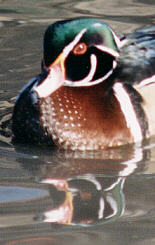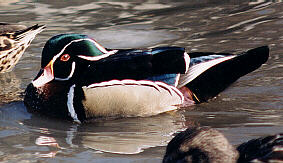The City Naturalist
Wood Duck
 Article
and Photos by Leslie Day
Article
and Photos by Leslie Day
WOOD DUCK (Aix sponsa, genus name aix from Greek, a water bird; species name sponsa, Latin, a betrothed in reference to its exquisite plumage, the phrase signifies "waterfowl in wedding raiments" as though it were arrayed for a marriage. "Wood" refers to its preferred habitat.)
The habitat of the wood duck was beautifully described by ornithologist Edward Howe Forbush in the 1920s: "Deep flooded swamps where ancient mossy trees overhang the dark still waters, secluded pools amid the scattered pines where water lilies lift their snowy heads and turtles bask in the sun, purling brooks flowing through dense woodlands where light and shade fleck the splashing waters, slow flowing creeks and marshy ponds - these are the haunts of the Wood Duck."
OTHER NAMES: Acorn Duck, Bridal duck, Carolina duck, Squealer, Summer duck, the Bride, Tree duck, Woody.
DESCRIPTION: The Wood Duck drake is considered to be the most beautiful duck in North America. Native to North America, the wood duck, 17-20 inches long, l.5 lbs., is a medium sized, dabbling, fresh water duck which summers from southern Canada south to Texas and from the Atlantic Coast to the Pacific in wooded rivers, ponds and swamps. It winters from New Jersey south to the Gulf Coast, Florida and Cuba.
 The Drake
(male) has darkly iridescent head with "slicked-back"
crest; eyes orange-red; head striped with white; bill a
variegated pattern of red, yellow, black and white; white throat;
breast and neck rich burgundy studded with star-like pattern of
white; back iridescent blue, green feathers; belly white; dark
wings and dark, square tail.
The Drake
(male) has darkly iridescent head with "slicked-back"
crest; eyes orange-red; head striped with white; bill a
variegated pattern of red, yellow, black and white; white throat;
breast and neck rich burgundy studded with star-like pattern of
white; back iridescent blue, green feathers; belly white; dark
wings and dark, square tail.
The female has grayish head with crest and prominent white ring around dark brown eyes; bill black; back brown, breast and flanks brownish; brownish underparts streaked with white. The wood duck sits low in water with its tail angled upward. On land it walks or runs with greater ease than most ducks. It frequently perches in trees.
FEEDING HABITS: In summer the wood duck feeds in streams and ponds on aquatic plants and insects. About 90% of food is plant life. It is especially fond of duckweed, and it eats seeds and tubers of sedges, grasses, smartweeds, wild rice. Wood ducks smetimes wander deep into the woods for acorns, beechnuts, hickory nuts, grapes and berries. Wood ducks eat more fruit and nuts than any other American duck. A male wood duck shot in 1959 in Minnesota had 56 acorns of bur oak in its throat and crop. Wood ducks also eat many aquatic insects, some minnows, frogs, tadpoles, snails and small salamanders.
 FAMILY
LIFE: Many wood ducks court and pair in fall and winter
when most are on inland waters of southern United States.The
female leads the drake back to the region where she was hatched
or to the area where she nested the year before. Family groups
often form small flocks of 15-20 in migration. An early spring
migrant, the wood duck arrives at its northern part of breeding
range in March - April after ice has left woodland ponds and
timbered wetlands. In the fall it moves south from October
through December.
FAMILY
LIFE: Many wood ducks court and pair in fall and winter
when most are on inland waters of southern United States.The
female leads the drake back to the region where she was hatched
or to the area where she nested the year before. Family groups
often form small flocks of 15-20 in migration. An early spring
migrant, the wood duck arrives at its northern part of breeding
range in March - April after ice has left woodland ponds and
timbered wetlands. In the fall it moves south from October
through December.
NESTING: Wood ducks usually build their nests in a natural hollow of the trunk or cavity in large branch of a tree; sometimes near water, but they can nest in the hollow of tree a mile or more from water. The nest may be in cavities 5-50 feet above ground. The hen seems to prefer nesting cavities 30 feet or more up above ground or water. The hen never changes the cavity and uses only her own down feathers for a nest after she begins laying eggs. She will also use man made nest boxes set on poles in standing water.
Eggs are laid sometime between April and June, resembling hen's eggs: dull white to brown-white. Usually 9-12 eggs are laid in a clutch. Incubation is by female, 27-33 days. At hatching, the young have sharp claws and climb to the opening of the nest cavity and then leap to the ground regardless of height, in response to calls of female on ground below. She then leads them to nearest water. They do not return to the nest cavity. The young first fly about 63 days after hatching.
FLIGHT: 39-55 m.p.h.
VOICE: Male's usual call is a sparrow-like jeeeee, high pitched and rising at end. The hen, from water or in flight, utters a loud hoo-eek and a sharp cr-r-ek, cr-r-ek when alarmed.
About Leslie Day | For Further Information
Copyright © 1996-2012 The 79th Street Boat Basin Flora and Fauna Society.
